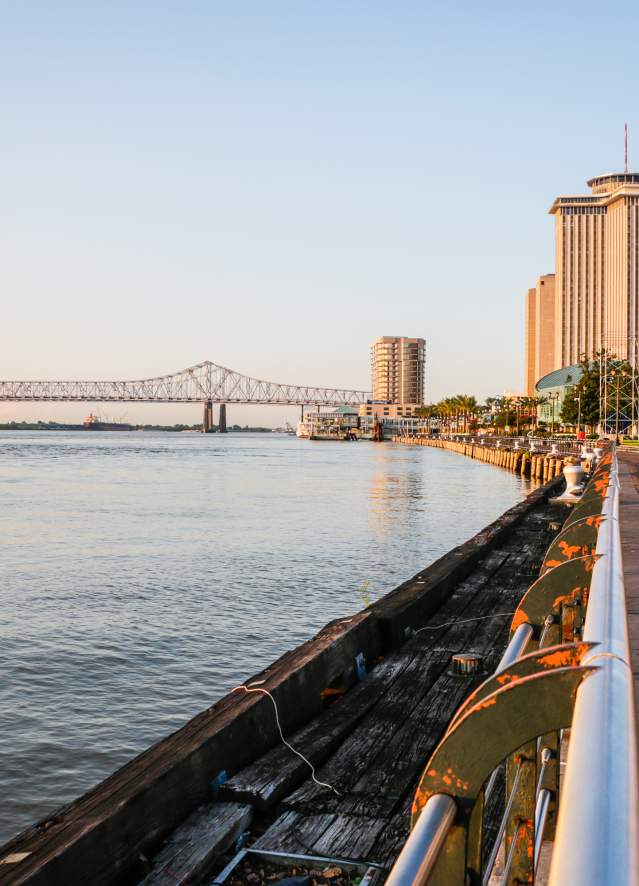New Orleans Weather
New Orleans is a great place to visit year-round. But you can make sure that you pack the correct clothing by viewing the average temperatures below. Of course, be sure to check the local weather a few days before your trip as well.
Average Temperatures and Precipitation in New Orleans By Month
|
Month
|
Avg High Temp
|
Avg Low Temp
|
Avg Rain Days
|
|---|---|---|---|
| January |
64° F
|
45° F
|
7 Days
|
| February |
66° F
|
47° F
|
6 Days
|
| March |
73° F
|
54° F
|
5 Days
|
| April |
79° F
|
61° F
|
4 Days
|
| May |
85° F
|
68° F
|
4 Days
|
| June |
90° F
|
74° F
|
10 Days
|
| July |
92° F
|
76° F
|
11 Days
|
| August |
92° F
|
76° F
|
12 Days
|
| September |
88° F
|
72° F
|
8 Days
|
| October |
81° F
|
62° F
|
5 Days
|
| November |
72° F
|
53° F
|
5 Days
|
| December |
65° F
|
46° F
|
6 Days
|
Hurricane Season Information
-
The official hurricane season for the Atlantic Basin (Atlantic Ocean, Caribbean Sea and Gulf of Mexico) is June 1st – November 30th. www.nhc.noaa.gov
-
Each year, an average of ten tropical storms develop. Many of these remain over the ocean. In nearly sixty years, only four hurricanes of Category 2 or higher have affected the New Orleans area. Weather.gov
-
Hurricanes affecting New Orleans for the past 100 years have been in Louisiana during late July, August or September. There has been only one hurricane in New Orleans in October - and none in November - over the past 100 years. NOAA
-
New Orleans has had 11 hurricanes of Category 2 or higher since 1855, an average of one hurricane almost every 15 years.
-
Since 1851, southeastern coastal states have had the following number of hurricanes [NOAA]:
- Florida – 118
- Texas- 65
- Louisiana - 55
- North Carolina - 52
- South Carolina - 32
- Alabama - 23
- Georgia - 22
- Mississippi - 16
Southeastern Flood Protection Authority
-
After Hurricane Katrina, the U.S. Army Corps of Engineers constructed the $14.5 billion Hurricane and Storm Damage Risk Reduction System. It is one of the most technically advanced coastal flood protection systems in the world.
-
Together, this system of barriers, sector gates, floodwalls, floodgates and levees, also known as the Southeast LA Flood Protection Authority, provides a veritable “wall” around the Greater New Orleans area, significantly reducing the risk of flooding for more than a million residents from a 100- year* storm. The flood defense is one of the strongest and largest in the world.
*The 100-year level means reduced flood risk from a storm surge that has a 1% chance of occurring or being exceeded in any given year. [https://www.floodauthority.org/].
New Orleans Seasons

Winter
The winter months tend to range from the low 40s to the mid-60s. Because it is humid, it may feel a little colder than it is. Pack a jacket, stockings/pants and some boots - layering is key. The Holidays, New Years, sporting events and Mardi Gras will keep you busy.
Check out more information on December, January, and February in New Orleans.

Spring
Spring is festival season in New Orleans and one of the prettiest times to visit. Temperatures average from the low 50s to the upper 70s. Flowers are blooming, but there are occasional showers. Pack a rain jacket, comfortable shoes, sunglasses, and your favorite festival outfit for the day time. A light sweater may be wanted for night time.

Summer
There’s no getting around it–Summer in the South is warm. June through August ranges from the mid 70s to upper 90s, and rain is common. Pack a sun hat, a bathing suit, a rain jacket and light clothing. Snowballs and swimming pools are calling your name.
Be sure to see all that’s happening in June, July, and August in New Orleans.

Fall
The crisp air and dropping temperatures make fall a beloved season around here. In early September, temperatures remain in the upper 80s, but begin to drop for the rest of the season. You can expect temperatures from the upper 70s to the mid 50s from October to November. Fall is the busiest time of year with festivals, sports, and events galore.
